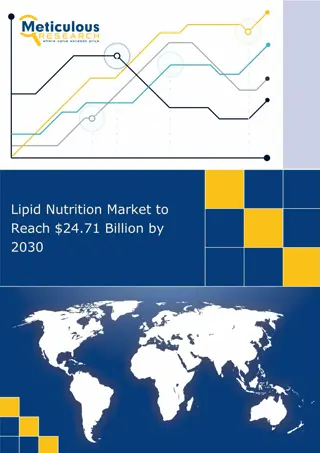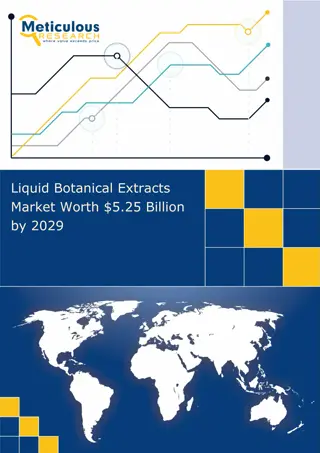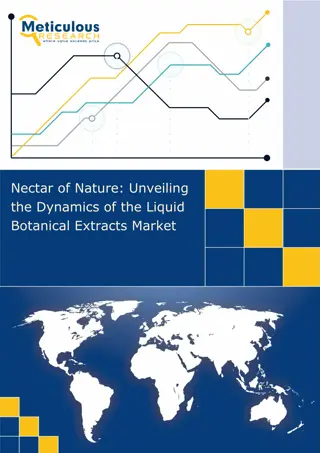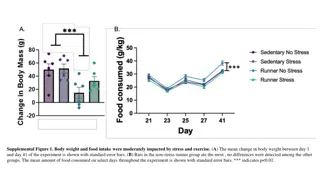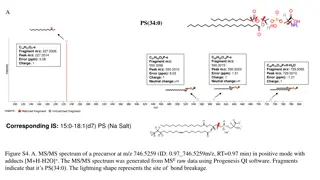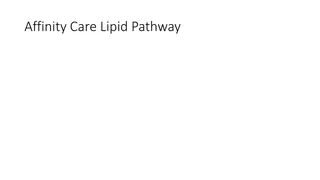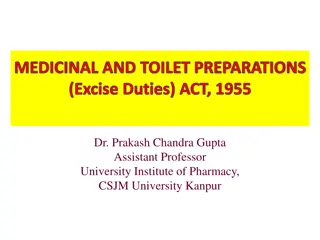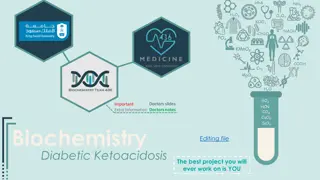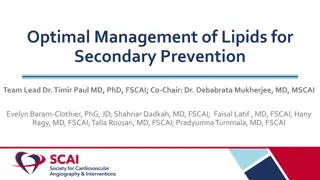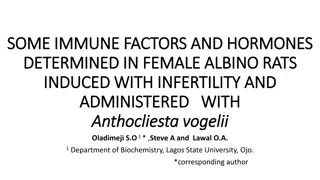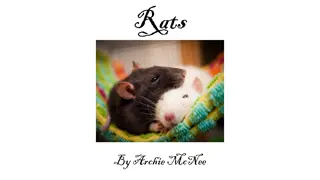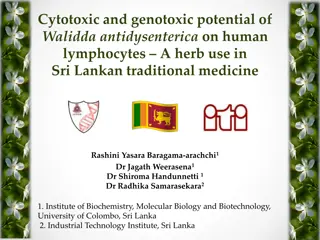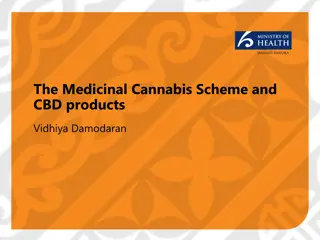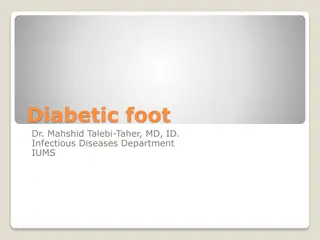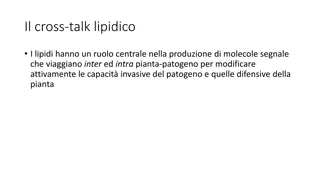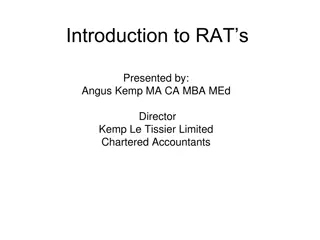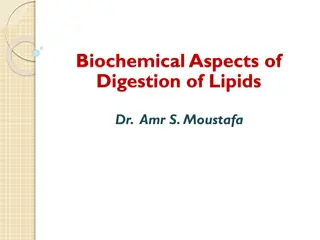Influence of Medicinal Plant Extracts on Lipid Peroxidation in Diabetic Rats
Traditional medicinal plant knowledge plays a crucial role in diabetes treatment. Free radicals and oxidative stress are key factors in diabetic complications. This study investigates the effects of three plant extracts on lipid peroxidation in diabetic rats, highlighting the potential benefits of natural remedies in addressing oxidative damage in diabetes.
- Medicinal plants
- Diabetes treatment
- Lipid peroxidation
- Antioxidant properties
- Diabetic complications
Download Presentation

Please find below an Image/Link to download the presentation.
The content on the website is provided AS IS for your information and personal use only. It may not be sold, licensed, or shared on other websites without obtaining consent from the author. Download presentation by click this link. If you encounter any issues during the download, it is possible that the publisher has removed the file from their server.
E N D
Presentation Transcript
Influence of three medicinal plant extracts on lipid peroxidation in streptozotocin induced diabetic rats A P Attanayake, K A P W Jayatilake, C Pathirana, L K B Mudduwa Faculty of Medicine, University of Ruhuna.
Traditional knowledge of medicinal plants has always guided the search for new cures. Virtually every indigenous culture in the world uses medicinal plants in some form or the other for treatment of ailments.
A multitude of plant materials have been described for the treatment of diabetes mellitus throughout the world. The herbal medicine has grown in popularity for the treatment of diabetes mellitus in Sri Lanka for a number of reasons.
Free radical mediated oxidative stress is a critical etiological factor implicated in several human diseases including diabetes mellitus (Bakirel et al., 2008). Oxidative stress Persistent and chronic hyperglycaemia Depletes the activity of antioxidative defense system Promotes de novo free radical generation
Free radicles react with biological molecules Reaction with these cell membrane constituents PUFA - most susceptible Lipid peroxidation
Any compound possessing radicle scavenging/ antioxidant properties might alleviate the damage of lipid peroxidation Use of therapeutic agents derived from medicinal plants seems to be an attractive alternative which could be used to treat/prevent diabetic complications induced by oxidative stress
Medicinal plants selected for the study bark bark leaves Coccinia grandis Gmelina arborea (Cucurbitaceae) (Verbenaceae) (Anacardiaceae) Extract : aqueous, refluxed Spondias pinnata (Jayaweera, 1982)
From previous studies Efficacy and dose response of the plant extracts on glucose tolerance in streptozotocin induced diabetic rats The minimum effective dose of each extract was found In vitro antioxidant activity of selected medicinal plant extracts possess antioxidant activities with high levels of polyphenolic compounds
The antidiabetic activity and in vivo antioxidant activity of selected plant extracts Biochemical parameters in vivo antioxidant activity blood/serum Antioxidant markers and enzymes Lipid peroxidation Histopathological assessment body weight food intake water intake Kidney, liver liver pancreas Histopathological and immunohistochemical assessment (Haddad et al., 2012)
Objective To evaluate the effect of aqueous extracts of Coccinia grandis, Gmelina arborea, Spondias pinnata on the extent of lipid peroxidation in streptozotocin induced diabetic rats. Diabetic rat model ; streptozotocin (65 mg/kg, ip) Wistar rats (n=6, b.wt. 200 2 5 g) Rats with fasting blood glucose concentration 180.00 > mg/dL was considered as hyperglycaemic and used for experiments.
Experimental design Group No Group 1 Healthy untreated rats 2 Diabetic untreated rats 3 Diabetic rats + Coccinia grandis (0.75 mg/kg) 4 Diabetic rats + Gmelina arborea (1.00 mg/kg) 5 Diabetic rats + Spondias pinnata (1.00 mg/kg) 6 Diabetic rats + Glibenclamide (0.50 mg/kg)
* 0 7 14 21 28 30 Days Treatment continued for 30 days *Collected liver tissue to determine extent of lipid peroxidation in liver homogenates
Estimation of the extent of lipid peroxidation Malondialdehyde (MDA) is formed as a catabolic product in the lipid peroxidation The common method of measuring MDA is based on the reaction with thiobarbituric acid (TBA). TBA + MDA MDA-TBA adduct + 2 H2O 95 C for 30 min pink colored complex measured the absorbance at 532nm MDA values are obtained using the extinction coefficient( ) 1.56 x 105 M-1 cm-1 Results were expressed as nmol/100 mg protein (Muriel et al., 2001; Okawa et al., 1979)
The results were evaluated by one way ANOVA and Dunnett s multiple comparison test. p<0.05 was considered as statistically significant. Ethical approval was obtained from the Ethical Review Committee, Faculty of Medicine, Galle.
Results Effect of plant extracts on the MDA level in liver homogenates Concentration of MDA (nmol/100mg protein) 40.00 35.00 30.00 25.00 20.00 15.00 10.00 5.00 0.00 Diabetic rats + glibenclami de 22.10 Healthy untreted rats Diabetic untreted rats Diabetic rats + C. grandis Diabetic rats + G. arborea Diabetic rats + S. pinnata Concentration of MDA 11.84 36.39 31.10 26.50 28.65
The increased levels of malondialdehyde in liver tissue of streptozotocin induced diabetic rats served as an index of elevated lipid peroxidation in diabetic condition. The increase in lipid peroxidation indicates increased oxidative stress, generating more free radicals. Significant reduction in lipid peroxidation may be attributed to the antioxidant activity of the selected aqueous extracts
Conclusion Aqueous leaf extract of Coccinia grandis, bark extracts of Gmelina arborea and Spondias pinnata provided protection against lipid peroxidation in liver tissue in diabetic rats.
References Dhawan B.N., Srimal R.C. (1998). Acute toxicity and gross effects. In: Laboratory manual for pharmacological evaluation of natural products . United Nations Industrial Development Organization and International Center for Science and High Technology: 17-20. Hadded P.S., Musallam L., Martineau L.C., Harris C., Lavoie L. (2012). Comprehensive evidence- based assessment and prioritization of potential antidiabetic medicinal plants: a case study from canadian eastern james bay cree traditional medicine. Evidence based Complementary and Alternative Medicine, 10: 1155. Jayaweera D.M.A. (1982). Medicinal plants used in Ceylon. National Science Foundation of Sri Lanka, M D Gunasena & Co, Part 1-5. Muriel P., Alba N., Perez-Alvarez V.M., Shibayama M., Tsutssumi V.K. (2001). Kupfer cells inhibition prevents hepatic lipid peroxidation and damage induced by carbon tetrachloride. Comparative Biochemistry and Physiology, 130: 219-226. Okawa H., Ohrnishi N., Yagi K., (1979). Assay for lipid peroxides in animal tissues by the thiobarbituric acid reaction . Analytical Biochemistry, 95: 351-358.
Acknowledgement Financial assistance by UGC/ICD/CRF 2009/2/5. Mrs B M S Malkanthie and Mr G H J M Priyashantha Department of Biochemistry, Faculty of Medicine, University of Ruhuna for laboratory assistance.





